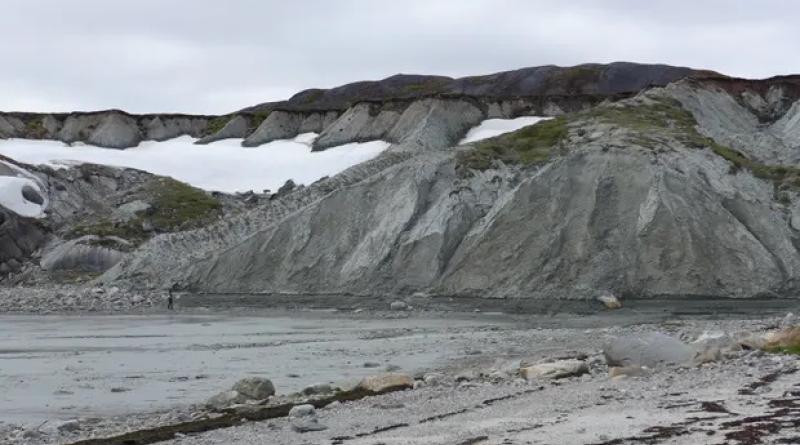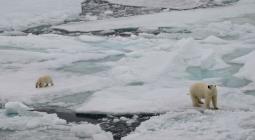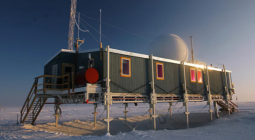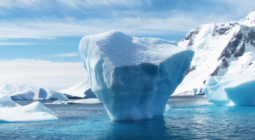Rock ‘flour’ from Greenland can capture significant CO2, study shows

Rock “flour” produced by the grinding under Greenland’s glaciers can trap climate-heating carbon dioxide when spread on farm fields, research has shown for the first time.
Natural chemical reactions break down the rock powder and lead to CO2 from the air being fixed in new carbonate minerals. Scientists believe measures to speed up the process, called enhanced rock weathering (ERW), have global potential and could remove billions of tonnes of CO2 from the atmosphere, helping to prevent extreme global heating.
Soil fertility naturally depends on rock weathering to provide essential nutrients, so enhancing the process delivers an extra benefit. Spreading the Greenland rock flour on fields in Denmark, including those growing barley for the Carlsberg brewery, significantly increased yields.
Greenland’s giant ice sheet produces 1bn tonnes a year of rock flour, which flows as mud from under the glaciers. This means the potential supply of rock flour is essentially unlimited, the researchers said, and removing some would have very little effect on the local environment.
The weathering process is relatively slow, taking decades to complete, but the researchers said ERW could make a meaningful difference in meeting the key target of net zero emissions by 2050. Phasing out the burning of fossil fuels remains the most critical climate action, but most scientists agree that ways of removing CO2 from the atmosphere will also be needed to avoid the worst effects of the climate crisis.
“If you want something to have a global impact, it has to be very simple,” said Prof Minik Rosing at the University of Copenhagen, who was part of the research team. “You can’t have very sophisticated things with all kinds of hi-tech components. So the simpler the better, and nothing is simpler than mud.”
He added: “Above all this is a scalable solution. Rock flour has been piling up in Greenland for the past 8,000 years or so. The whole Earth’s agricultural areas could be covered with this, if you wished.”
Other researchers are investigating the use of mechanically ground rock for ERW. “But unlike other sources, glacial rock flour does not need any processing,” said Dr Christiana Dietzen, also at the University of Copenhagen. The rock flour weathers extremely slowly in the cold conditions in Greenland, but the process speeds up when it is spread in warmer places.
The research on the CO2 uptake of Greenland rock flour, published in the International Journal of Greenhouse Gas Control, estimated that 250kg of CO2 can be trapped per tonne of rock flour. After three years in soil in Denmark, the researchers found about 8% of this had been achieved. The scientists also calculated that 27m tonnes of CO2 could be captured if all farmland in Denmark was spread with the rock flour, an amount similar to the country’s total annual CO2 emissions.Another study by the same team, published in the journal Nutrient Cycling in Agroecosystems, showed increases in yields of maize and potatoes of 24% and 19% respectively after rock flour was spread in Denmark. Dietzen hopes the first commercial applications will be spread within three years.
The team is also running experiments in less fertile soils, in Ghana, where even greater increases in maize yield have been seen. “In environments like Ghana, the fertiliser benefit alone may be enough reason to import glacial rock flour,” Dietzen said, though the impact of transporting the rock flour long distances from Greenland would have to be weighed up.
Other ERW research has used mechanically ground basalt and a 2020 study estimated that treating about half of global farmland with this could capture 2bn tonnes of CO2 each year, equivalent to the combined emissions of Germany and Japan.
Prof David Beerling at the University of Sheffield, who led the 2020 work, said basalt had significant advantages. Its chemical composition absorbs CO2 faster than glacial rock flour, may increase crop yields by more and it is widely available close to many farming areas. “We need all the weapons we can muster in the fight against climate change and my sense is that glacial rock flour could be a useful one,” he said. “But it is not a gamechanger.”
However, the rock flour is much finer than the ground basalt and so exposes more surface area to weathering. The advantages and disadvantages of both types of rock dust are still being studied. The Danish group is planning trials in Australia and assessing the energy requirements of shipping. Beerling’s team expects to publish results of yield gains in corn following basalt application in the US in the near future. “I don’t think it has to be one or the other. I think there’s probably room for both,” said Rosing.
Other proposed ways of pulling CO2 from the atmosphere include using technology to capture it directly from the air, or growing energy crops, burning them to produce electricity and then burying the CO2 emissions. The 2020 study suggested ERW would be less expensive than either and, unlike energy crops, does not compete with food for land.
Greenland is usually in the news because of the huge and accelerating melting of its ice cap, which is driving up sea level. Rosing, who is originally from Greenland, said: “It would be much nicer for the nation to be part of the [climate] solution, rather than just a symptom of the problem.”
cover photo:Eight-thousand-year-old marine deposits, exposed by the slow rise of Greenland after the last ice age. The cliffs are about 15 metres high. Photograph: Minik Rosing





